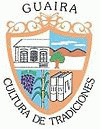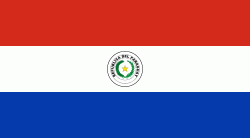Guairá Department (Departamento del Guairá)
 |
 |
It covers a surface of 3846 km2, with a population of 178,130 inhabitants (2002). One can arrive there by taking the Number 8 Blas Garay Road. It was founded on May 14, 1570, by Ruiz Diaz de Melgarejo.
Until circa the 19th century, the departmenti was called La Guayra or Guairá, or also La Pineria (meaning "the Cury forests"); the region was under the jurisdiction of Cabildo de Asunción on the east of the Paraguay River until the line of the Tratado de Tordesillas. This place was also site of the first great Jesuit mission of Guayra, having the borders around the northern limits, the Paranapanema River, or according to other versions, the Tiete River, and the Iguazu River on the south.
It used to be called Guayra o Guaira, a large territory that currently corresponds to the state of Parana. From the 16th to 18th centuries, the Spanish founded cities (Ontiveros, Ciudad Real del Guayra, Villa Rica del Espiritu Santo), and the Jesuits founded some reservations, also under the Spanish jurisdiction, such as San Ignacio Guazu, Santa Maria del Iguazu (which is today Foz do Iguacu) Pirapo, Loreto, etc.
Such cities were devastated by the bandeirantes, and they had to migrate a great part of the population to the west of the Parana River (where Villa Rica was re founded-the current-day Villarica) or to the south of the Iguazu River (where San Ignacio was re founded-with the name of San Ignacio Mini and Loreto among others).
The Guayra Waterfall (or Salto Canendiyu), called Salto das Sete Quedas by the Brazilians, on the Paraná River, almost to the crossing with the parallel 24ªS, was the natural navigation limit of the river. The current-day Paraguayan city called Salto del Guaira, and the Brazilian Guaira, indicate the approximate place where the beautiful and famous waterfalls are, covered by the waters of the Itaipu Dam since the 1980s.
The Brazilian occupation of the Guairá region was decided in 1870, at the end of the Paraguayan War, being later baptized with the name of Guaira, to the small department located in the center of the Eastern Region, in a territory which was not included in the original Guayra.
Map - Guairá Department (Departamento del Guairá)
Map
Country - Paraguay
 |
 |
| Flag of Paraguay | |
Spanish conquistadores arrived in 1524, and in 1537 established the city of Asunción, the first capital of the Governorate of the Río de la Plata. During the 17th century, Paraguay was the center of Jesuit missions, where the native Guaraní people were converted to Christianity and introduced to European culture. After the expulsion of the Jesuits from Spanish territories in 1767, Paraguay increasingly became a peripheral colony, with few urban centers and settlers. Following independence from Spain in the early 19th century, Paraguay was ruled by a series of authoritarian governments characterized by nationalist, isolationist and protectionist policies. This period ended with the disastrous Paraguayan War (1864–70), during which the country lost half its prewar population and around 25–33% of its territory to the Triple Alliance of Argentina, Brazil and Uruguay. In the 20th century, Paraguay faced another major international conflict—the Chaco War (1932–35) against Bolivia—in which it prevailed. Afterwards, the country came under a succession of military dictators, culminating in the 35-year regime of Alfredo Stroessner, which lasted until his overthrow in 1989 by an internal military coup. This marked the beginning of Paraguay's democratic era, which continues to this day.
Currency / Language
| ISO | Currency | Symbol | Significant figures |
|---|---|---|---|
| PYG | Paraguayan guaranà | ₲ | 0 |
| ISO | Language |
|---|---|
| GN | Guarani language |
| ES | Spanish language |















